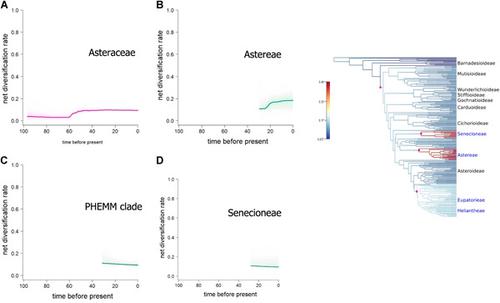当前位置:
X-MOL 学术
›
J. Syst. Evol.
›
论文详情
Our official English website, www.x-mol.net, welcomes your feedback! (Note: you will need to create a separate account there.)
The importance of the Mexican taxa of Asteraceae in the family phylogeny
Journal of Systematics and Evolution ( IF 3.7 ) Pub Date : 2020-09-09 , DOI: 10.1111/jse.12681 Patricia Rivera 1, 2 , José Luis Villaseñor 2 , Teresa Terrazas 2 , José L. Panero 3
Journal of Systematics and Evolution ( IF 3.7 ) Pub Date : 2020-09-09 , DOI: 10.1111/jse.12681 Patricia Rivera 1, 2 , José Luis Villaseñor 2 , Teresa Terrazas 2 , José L. Panero 3
Affiliation

|
Asteraceae is the largest plant family in México with about 417 genera and 3113 species, and with more than 60% of them being endemic. Phylogenetic relationships at subfamily and tribal levels have been previously resolved employing both nuclear and plastid molecular markers. However, Asteraceae species native to Mexico have been underrepresented in such phylogenies. To tackle this issue, the taxon sampling of this study included 90 Asteraceae species native to México, four species from the Caribbean, 119 previously sequenced species, and six outgroups. With this sampling, all the Asteraceae subfamilies and all of the tribes recognized to date are represented. The analyzed dataset consisted of eleven chloroplast markers (atpB, matK, ndhC, ndhD, ndhF, ndhI, ndhJ, ndhK, rbcL, trnL-trnF, and 23S-trnA). We present two phylogenetic reconstructions obtained by maximum likelihood and pseudocoalescent methods. Besides, we present a time-calibrated phylogeny, which is used to infer the best configuration of diversification rate shifts. Our results show that Mexican species are distributed mainly in the subfamily Asteroideae (80 species), followed by Cichorioideae (6 species), Carduoideae (2 species), and Mutisioideae (2 species). Four net diversification rate shifts were found: One near the base of the tree and four within Asteroideae subfamily. Our extended sampling of the family with the representation of native species to Mexico allowed us to identify important events in the evolutionary history of the family.
中文翻译:

菊科墨西哥分类群在家庭系统发育中的重要性
菊科是墨西哥最大的植物科,约有417属3113种,其中60%以上为地方性植物。以前已经使用核和质体分子标记解决了亚科和部落水平的系统发育关系。然而,原产于墨西哥的菊科物种在此类系统发育中的代表性不足。为了解决这个问题,本研究的分类群抽样包括 90 种原产于墨西哥的菊科物种、4 种来自加勒比海的物种、119 种先前测序的物种和 6 个外群。通过这种抽样,所有菊科亚科和迄今为止公认的所有部落都得到了代表。分析的数据集包括 11 个叶绿体标记(atpB、matK、ndhC、ndhD、ndhF、ndhI、ndhJ、ndhK、rbcL、trnL-trnF和23S-trnA)。我们提出了通过最大似然和伪聚结方法获得的两种系统发育重建。此外,我们提出了一个时间校准的系统发育,用于推断多样化速率变化的最佳配置。我们的研究结果表明,墨西哥物种主要分布在 Asteroideae 亚科(80 种)中,其次是 Cichorioideae(6 种)、Carduoideae(2 种)和 Mutisioideae(2 种)。发现了四种净多样化率变化:一种靠近树的基部,四种在 Asteroideae 亚科内。我们对具有墨西哥本土物种代表性的家族进行了扩展抽样,这使我们能够确定该家族进化史上的重要事件。
更新日期:2020-09-09
中文翻译:

菊科墨西哥分类群在家庭系统发育中的重要性
菊科是墨西哥最大的植物科,约有417属3113种,其中60%以上为地方性植物。以前已经使用核和质体分子标记解决了亚科和部落水平的系统发育关系。然而,原产于墨西哥的菊科物种在此类系统发育中的代表性不足。为了解决这个问题,本研究的分类群抽样包括 90 种原产于墨西哥的菊科物种、4 种来自加勒比海的物种、119 种先前测序的物种和 6 个外群。通过这种抽样,所有菊科亚科和迄今为止公认的所有部落都得到了代表。分析的数据集包括 11 个叶绿体标记(atpB、matK、ndhC、ndhD、ndhF、ndhI、ndhJ、ndhK、rbcL、trnL-trnF和23S-trnA)。我们提出了通过最大似然和伪聚结方法获得的两种系统发育重建。此外,我们提出了一个时间校准的系统发育,用于推断多样化速率变化的最佳配置。我们的研究结果表明,墨西哥物种主要分布在 Asteroideae 亚科(80 种)中,其次是 Cichorioideae(6 种)、Carduoideae(2 种)和 Mutisioideae(2 种)。发现了四种净多样化率变化:一种靠近树的基部,四种在 Asteroideae 亚科内。我们对具有墨西哥本土物种代表性的家族进行了扩展抽样,这使我们能够确定该家族进化史上的重要事件。



























 京公网安备 11010802027423号
京公网安备 11010802027423号